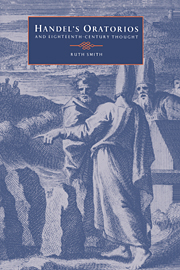Book contents
- Front Matter
- Contents
- Acknowledgements
- Abbreviations
- Introduction
- PART 1 ENGLISH ORIGINS OF ENGLISH ORATORIO
- PART II THE PATRIOT LIBRETTO FROM THE EXCISE BILL TO THE JEW BILL: ISRAELITE ORATORIOS AND ENGLISH POLITICS
- Chapter 8 Political events and political thought
- Chapter 9 Allegorical politics
- Chapter 10 Moral politics
- Chapter 11 ‘Esther’ to ‘Athalia’
- Chapter 12 In time of war
- Chapter 13 Images of government
- Chapter 14 The conflict of public and private interests
- Chapter 15 Coda: the end of Handel's Israelite oratorios
- Appendix I Libretto authors and sources
- Appendix 2 The oratorios and Methodism
- Notes
- Bibliography of sources cited
- Index
Chapter 11 - ‘Esther’ to ‘Athalia’
Published online by Cambridge University Press: 22 September 2009
- Front Matter
- Contents
- Acknowledgements
- Abbreviations
- Introduction
- PART 1 ENGLISH ORIGINS OF ENGLISH ORATORIO
- PART II THE PATRIOT LIBRETTO FROM THE EXCISE BILL TO THE JEW BILL: ISRAELITE ORATORIOS AND ENGLISH POLITICS
- Chapter 8 Political events and political thought
- Chapter 9 Allegorical politics
- Chapter 10 Moral politics
- Chapter 11 ‘Esther’ to ‘Athalia’
- Chapter 12 In time of war
- Chapter 13 Images of government
- Chapter 14 The conflict of public and private interests
- Chapter 15 Coda: the end of Handel's Israelite oratorios
- Appendix I Libretto authors and sources
- Appendix 2 The oratorios and Methodism
- Notes
- Bibliography of sources cited
- Index
Summary
Elucidating the possible political implications of an oratorio libretto, it will by now be agreed, is unlikely to be plain sailing. This is abundantly illustrated by Esther, which not only demands attention as Handel's first English oratorio but has the most complicated textual history. Trying to ‘unpack’ its meaning demonstrates the delicacy of the operation and the often unexpectedly rich nature of its results.
The story begins in France. The first performances of Racine's Esther, in January and February 1689, by the protégées of Mme de Maintenon's school of St Cyr, were given to a highly select court audience. At the third performance, 5 February, this included the recently deposed James II of England and his queen, Mary of Modena. The cast included Mile Marie-Claire Decamps de Marcilly, who so enchanted the Marquis de Villette in her role of Zarès that he subsequently married her (thus causing a rift with Mme de Maintenon, who was also the Marquis' aunt). The possible importance to Handel's Esther of both Marie-Claire's participation and its outcome will appear presently.
In England there was no performance of Racine's Esther on the public stage in the early eighteenth century, but the play was known in French – Swift had Racine in his library, as did Handel's friend John Arbuthnot, a member of the Burlington House and Cannons circles which generated the first Esther libretto.
- Type
- Chapter
- Information
- Handel's Oratorios and Eighteenth-Century Thought , pp. 276 - 287Publisher: Cambridge University PressPrint publication year: 1995



